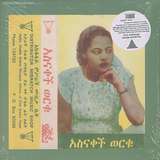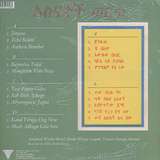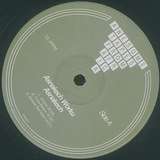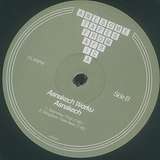Asnakech Worku: Asnaketch
Proper representation of outstanding music from 1970s Ethiopia (w/ download code)
- A1 Jinyew
- A2 Tche Belew
- A3 Awkew Beneber
- B1 Baynelay Yidal
- B2 Mingizem Yene New
- C1 Tew Begize Giba
- C2 Sak Bleh Askegn
- C3 Abyotegnaw Jegna
- D1 Kand Yerega Deg New
- D2 Mech Alkugn Lela Sew
There is perhaps no woman more cherished in modern Ethiopian history than Asnakech Worku. As a musician, actress, dancer and cultural icon, Asnakech inspired and challenged society for decades, until her death in 2011. From her beginnings as Ethiopia’s first theater actress in 1952 to her acclaimed film appearances to her days as a club owner-turned-master musician, Asnakech’s inimitable confidence and charm made her a household name. She earned endless accolades across the artistic spectrum.
She made seminal recordings of unforgettable original compositions, as well as legendary renditions of traditional songs, that became national staples. With a singular sense of style, glamour and sex appeal that sometimes stunned mainstream society, Asnakech wore clothes no one else wore and said things no one else said. Staid notions of how women should dress and behave didn’t apply to her. Battling a mentality that until the early 1950s had men wearing dresses to play female roles in the theater, Asnakech became a national treasure on her own terms.
Her family wasn’t pleased with Asnakech becoming an azmari—an itinerant praise musician who sings, often in bars, for tips—and didn’t bother her, especially after Emperor Haile Selassie I began to emphasize theater and music in society, officially legitimizing her career. Asnakech became an internationally-celebrated performer of Ethiopia’s ancient harp, the krar, making her one of the most visible female musicians of the 20th century. All this while leaving controversy, broken hearts and a changed cultural landscape in her wake.
In 1975, keyboardist and bandleader Hailu Mergia got a call from the owner of Misratch Music Shop to do a recording with Asnakech and he went for it. This recording is a nearly-forgotten artifact of the remarkable icon’s singular legacy, remastered and available outside Ethiopia for the first time. It also provides a rare glimpse into Mergia’s work as a arranger-sideman in the Addis Ababa music scene.
The Krar
The krar is one of the oldest and most iconic traditional instruments in Ethiopia and Eritrea. A lyre, or harp, with 6 strings attached to a cloth-wrapped wooden crossbar, the sound emits from a resonator bowl covered with animal skin. The instrument comes in a variety of sizes and has relatives in the Middle East and Mediterranean as well as other parts of East and Central Africa. Used for secular music, the krar is normally accompanied by at least one vocalist and plays monophonic melodic lines using the region's traditional pentatonic scales, called kignit. These characteristic scales form the basis of the sound listeners worldwide now recognize. They are also the names of well-known songs: tizita, bati, ambassel and anchi hoye lene, of which there are numerous recorded versions. The krar has been around for centuries, likely introduced to the Kingdom of Axum in Northern Ethiopia via the Nile River a little less than 2000 years ago.
Memories of Asnakech by Hailu Mergia
Asnakech had a club uptown—in Dejach Wube area, a popular part, there were a bunch of clubs. It was the late 1950s in the Ethiopian calendar, so probably the mid-1960s. I saw her there for the first time, not in the theater. She used to perform for friends there, sometimes we stayed there after hours. She would play krar. Back then she was very young, haha. Whatever you would request, she would play, many traditional songs, solo. Sometimes some guys would come there and play with her.
Someone took me there just to have fun. I was not a known guy back then, she was a famous lady. So I introduced myself but I was just a fan. I knew her name but hadn’t seen her but I’d heard her music on the radio. She said, “Oh you’re a new guy, good for you,” the kind of supporting things she usually said to a young musician. After that, when I used to play in Zula club or next door to her club at Patrice Lumumba club (Acegedech Nightclub), she used to come and dance with her friends once in a while.
After so many years, in the mid 1970s, the owner of this music store contact me and he told me that he is planning to have a cassette with Asnakech. So I made a handshake deal and we started the recording.
I’m proud that I played with her, that we did this album. It’s nice to play with somebody you admire, to be able to say, I played with Asnakech when she was great. She was a very polite person, always talking good about other people. In particular, to me she was a very modern lady. If you’re not a dead person your heart is gonna beat, young or old, when you see that lady dressing, any kind of dress western dress or traditional dress. She was a modern lady, dressed in the latest designer dresses, more than anyone else back then. Oh! That lady was different. She was a dancer and an actress. At the same time she was very beautiful and everybody talked about her. She had a style when she smoked, the way she took the cigarette in her fingers, it was an art. Her hair was so beautiful, long hair. Asnakech? Forget it, man.
Some of the songs are traditional, some are her compositions. You can listen to songs like these at home with family, while sitting or reading, in the after-hours at the club, while you’re washing the dishes. When you’re driving, a bunch of people listen while driving. It depends what time when you want to listen. Some people they listen to this kind of love music when they have a good relationship, somebody passed away or somebody stopped dating each other and have emotional flashbacks to what happened in their lives. Sometimes I listen to this music while I sit by the fireplace and I take some whisky, during the holiday time for relaxation. You can listen to this music any time. Especially for lovers.
*On the occasion of the first anniversary of her passing, Asnakech's family and friends held a memorial. This is the text accompanying that event, composed by Asnakech's biographer, Getachew Debalke.
We would like to present our greetings. Please, be present with your spouse as we mark one year of grieving for the artist Asnakech Worku on September 6, 2015 E.C. [Ethiopian Calendar], at 12:30 in Kidst Selassie Cathedral church.
Address :- 6 kilo near Egypt Embassy
Short Biography
Ethiopia lost a great queen of art. Today marks one year since our loss of the famous and respectful artist who combines music and theatre for the first time. This day marks a year of deep grief. Yes, both of them lost Asnakech. They lost their biggest blessings. From now on she will not be there. But, her children will be with us forever. This is the short biography of this great artist.
Artist Asnakech Worku was born in 1926 E.C., in Addis Ababa, Gedam Sefer, near Sidst Kilo. She was only three years old at the time her mother passed away. Due to this, her godmother took her and raised her.
At that time getting education nearby was impossible. There was no other choice than spending time with religious clergymen. Due to this, Asnakech started to learn letters and she was able to finish the book of David.
Her biography tells that, starting from a young age, Asnakech grew up singing living with her godmother. Singing sad songs when she felt low, singing alone when she felt happy, and dancing when singing were her natural gifts. Memorizing songs was also one of her gifts.
Her hope was to start learning in the only school found nearby called Etege Menen girls’ school.After she tried hard to get in, she was asked to shave her head for a medical checkup. But she refused and didn’t start studying there.
She sang a song about the horrifying truth of migration. Asnakech got the admiration of German journalists.
On January 27, 2000, there was a ceremony for women in the arts. Asnakech was the only Ethiopian representative. She performed an amazing show using only one instrument, the krar. She got an award for that.
Asnakech Worku, the woman of love, the talented artist, the symbol of talent, has performed her plays in various countries. [...]
In 1991, Asnakech received a lifetime achievement award from the media.
Asnakech used to dance to traditional music, she used to sing, she used to perform in plays, she used to dance to modern dance, and she was just gifted. Art is created by mankind. These harmonious and beautiful memories of Asnakech were created by her. Her beautiful works will be remembered forever.
Birth and death are God’s power. Mankind has only a right to live the short time given to him. Even when we are alive, we live on the verge of death. This kind, generous and talented artist Asnakech, was sick for a long time. She was battling death. Her generous friends, her co-actors, were also part of the battle. They were by her side for years. They were fighting with her. But today, by the will of God, they and Asnakech lost the battle.
On September 4, 2004 E.C., while receiving her treatment, the 78-year-old Asnakech passed away.
On September 5, 2004 E.C, her funeral was held on Kidst Sellasie Cathedral ye Arbegnoch mekane mekabr. We would like to give our condolences for her family, her friends, her co-actors and her fans.



